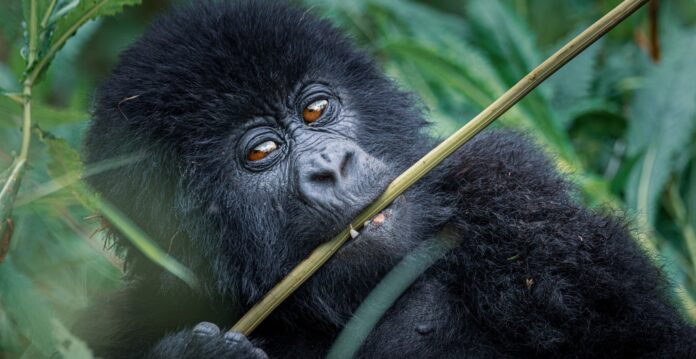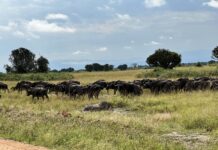The taxonomy of mountain gorillas:
Kingdom: Animalia
Phylum: Chordata
Class: Mammalia
Order: Primates
Family: Hominidae
Genus: Gorilla
Species: Gorilla beringei
Subspecies: Gorilla beringei beringei (mountain gorilla)
The scientific name of mountain gorillas is Gorilla beringei beringei. They are one of the two subspecies of eastern gorillas, the other being the eastern lowland gorilla (Gorilla beringei graueri). The mountain gorillas are found only in the high-altitude forests of the Virunga Massif, which spans Uganda, Rwanda, and the Democratic Republic of Congo.
General perception of the Mountain Gorillas
Mountain gorillas are a subspecies of eastern gorillas found only in the high-altitude forests of the Virunga Massif, which spans Uganda, Rwanda, and the Democratic Republic of Congo. Uganda is home to roughly half of the global population of mountain gorillas.
Mountain gorillas are critically endangered, with an estimated population of only around 1,000 individuals remaining in the wild. They are slightly smaller than their lowland counterparts, with males weighing up to 440 pounds and females weighing up to 220 pounds.
Mountain gorillas live in social groups led by a dominant silverback male, who protects the group and is responsible for mating with the adult females. These groups can range in size from 2 to 40 individuals, although the average group size is around 10.
Mountain gorillas are primarily herbivores, with a diet consisting of leaves, shoots, bark, and fruits. They are known for their gentle nature and close family bonds, with mothers caring for their offspring for several years and siblings often playing together.
Conservation efforts have helped to increase the population of mountain gorillas in recent years, with initiatives such as habitat protection, anti-poaching patrols, and responsible tourism. Visitors can take guided tours to see these magnificent creatures in their natural habitat in Uganda’s Bwindi Impenetrable National Park and Mgahinga Gorilla National Park, which are among the most popular tourist destinations in the country.
Characteristics of mountain gorillas:
Size: Mountain gorillas are the largest primates on Earth, with adult males weighing up to 440 pounds and standing up to 5.5 feet tall.
Fur: Mountain gorillas have longer and thicker fur than other gorilla subspecies, which helps them to stay warm in the cool, high-altitude forests where they live. Their fur is black or dark brown in color, with a silvery-gray patch on the back of the males.
Nose: Mountain gorillas have a distinctive broad and flat nose, which is one of the features that distinguishes them from other gorilla subspecies.
Social behavior: Mountain gorillas live in social groups led by a dominant silverback male, who protects the group and is responsible for mating with the adult females. These groups can range in size from 2 to 40 individuals, although the average group size is around 10.
Diet: Mountain gorillas are primarily herbivores, with a diet consisting of leaves, shoots, bark, and fruits.
Intelligence: Mountain gorillas are highly intelligent and have been observed using tools, solving problems, and exhibiting other complex behaviors.
Endangered status: Mountain gorillas are critically endangered, with only around 1,000 individuals remaining in the wild due to habitat loss, poaching, and other threats. Conservation efforts have helped to increase their population in recent years, but they remain a vulnerable species that requires ongoing protection.
Habitat of the Mountain Gorillas
Mountain gorillas are found only in the high-altitude forests of the Virunga Massif, which spans Uganda, Rwanda, and the Democratic Republic of Congo. This region is part of the Albertine Rift, a narrow strip of mountains and forests that runs along the western edge of East Africa.
The mountain gorillas live in dense bamboo and montane forest habitats at elevations ranging from 8,000 to 13,000 feet above sea level. These forests are characterized by cool temperatures, high rainfall, and misty conditions. The thick vegetation provides cover and protection for the gorillas, as well as a source of food in the form of bamboo shoots, leaves, and fruits.
The Virunga Massif is also home to a wide variety of other plant and animal species, including other primates, elephants, buffalo, and a range of bird species. However, the mountain gorillas are a flagship species for the region and are a major draw for tourism, research, and conservation efforts.
The mountain gorillas’ habitat is under threat from deforestation, poaching, and other human activities. Conservation efforts are focused on protecting their habitat, reducing human-wildlife conflict, and promoting sustainable tourism and development in the region.






